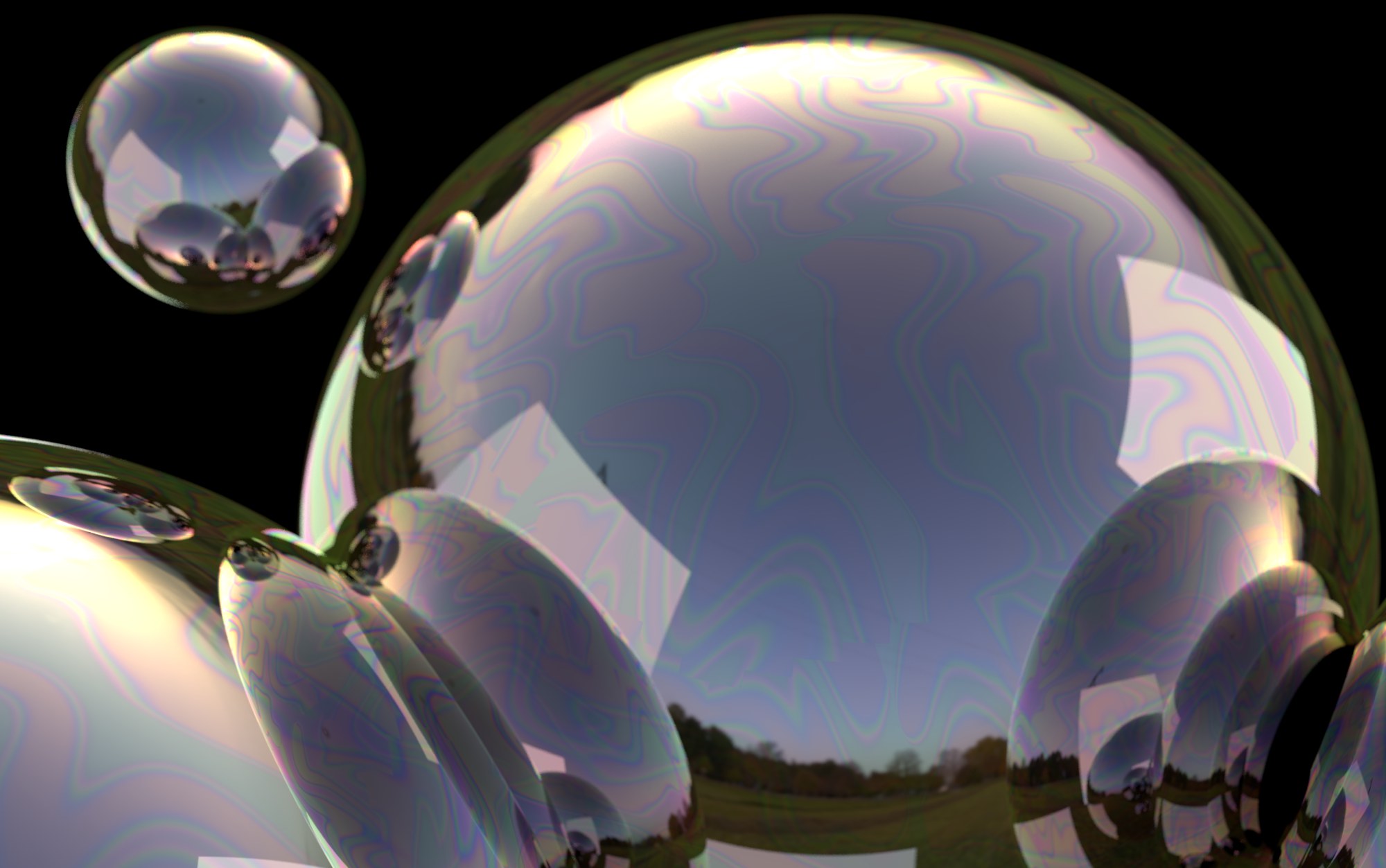 Thin Film Shader 薄膜着色器Basic 基础Shader 着色器
Thin Film Shader 薄膜着色器Basic 基础Shader 着色器
Shader Properties
颜色
Use this setting if you want to color the thin film reflection. The color defined here is multiplied with the reflection. However, only a pure white would be physically correct (without a shader loaded into the Texture field).
如果你想给薄膜反射着色,可以使用这个设置。这里定义的颜色与反射相乘。但是,只有纯白色在物理上是正确的(没有加载到纹理字段的着色器)。
混合强度[0. . 100% ]
The Mix Strength setting can be used to steplessly mix a shader in the Texture field with the defined Color.
混合强度设置可以用来无级混合着色器在纹理领域与定义的颜色。
厚度(nm)[0. . 5000]
 Varying 变化Thickness 厚度
values for a perfect soap bubble. 完美肥皂泡的价值
Varying 变化Thickness 厚度
values for a perfect soap bubble. 完美肥皂泡的价值
This setting defines the thickness of the thin film in nanometers (nm). The default value of 500nm represents an approximate median wave length for visible white light. To achieve realistic-looking results, values should be used that reflect those in the real world.
这种设置决定了纳米(nm)薄膜的厚度。默认值500nm 代表可见光的近似中位波长。为了得到看起来真实的结果,应该使用能够反映现实世界的值。
As you can see in the image above, colors change greatly within a thickness of 800, while greater values increasingly diminish the violet/green share until the reflection is completely white. A Thickness value of 0 will not produce any reflection at all.
正如你在上面的图片中所看到的,在800的厚度范围内颜色变化很大,而更大的值会逐渐减小紫色/绿色的分量,直到反射完全变白。厚度值为0不会产生任何反射。
In the real world, the thin film’s thickness will vary. This can be defined using the following Variation setting.
在现实世界中,薄膜的厚度会发生变化。这可以通过下面的变化设置来定义。
Variation (nm)[0..5000]
Texture
变异(nm)[0. . 5000]纹理
The vibrantly shimmering effect of soap bubbles or oil film on water is caused by variations in the thin film’s thickness.
肥皂泡或油膜对水的闪烁效果是由薄膜厚度的变化引起的。
The Variation (nm) value defines the variation of the thin film’s thickness from top to bottom. If, for example, a Thickness value of 400 and a Variation value of 100 are defined, the thin film’s thickness will vary between 300nm and 500nm. The exact distribution is defined using the grayscale values of the image in the Texture field.
变化(纳米)值定义了薄膜的厚度从上到下的变化。例如,如果定义厚度值为400和变化值为100,那么薄膜的厚度将在300纳米到500纳米之间变化。精确的分布是使用纹理域中图像的灰度值定义的。
The following applies:
以下规定适用于:
Gray tones will generate a correspondingly greater or lesser thickness.
灰色调会相应地产生较大或较小的厚度。
The values above applied to a texture would produce the following result:
上面应用到纹理的值会产生以下结果:

Since a soap bubble’s thickness increases towards the bottom (gravity causes the water to run downwards), a light-to-dark gradient should always be integrated into the shader.
由于肥皂泡的厚度增加向底部(重力导致水向下运行) ,一个光明到黑暗的梯度应该始终纳入着色器。
返回预设值[1. . 10]
If light hits the thin film it will be refracted differently, depending on the material (see also s.a. Refraction). This value can be defined here. The selection menu contains several default materials whose values will be set automatically when selected.
如果光线照射到薄膜上,折射会有所不同,这取决于材质。这个值可以在这里定义。选择菜单包含几个默认材质,它们的值将在选择时自动设置。
Generally speaking, smaller values will produce more colorful results and larger values will produce correspondingly less colorful results. The best results are achieved when realistic values are used. Select the thin film’s material (not the material on which the thin film lies) from the drop-down menu. Note that this refraction index is only used to calculate the coloration of the thin film - real-world calculations such as the divergence of render rays are not made!
一般来说,较小的值会产生更多的色彩结果,较大的值会产生相应的色彩较少的结果。当使用现实的值时,可以取得最好的结果。从下拉菜单中选择薄膜的材质(而不是薄膜所在的材质)。请注意,这个折射率仅用于计算薄膜的着色——实际计算中,例如渲染光线的发散是不会产生的!
光谱样品[1. . 100]
This setting can be used to fine-tune the overall quality. Lower values will produce correspondingly less realistic results while higher values will produce better results. As always, the better the quality, the longer the render time will be.
此设置可用于微调整体质量。较低的数值将相应地产生较不现实的结果,而较高的数值将产生较好的结果。和往常一样,质量越好,渲染时间就越长。
Note that very high values will at some point not improve quality to the same degree.
请注意,非常高的值在某种程度上不会提高质量到相同的程度。
A somewhat more technical explanation: Internally, the shader uses spectral colors in its calculations (takes different behavior into account (e.g., the varied refraction strength of different spectral colors)). If an RGB value should be generated from these spectral colors, the total number of samples defined here will be taken from the entire visible spectrum and averaged from this RGB value.
一个更技术性的解释是: 在内部,着色器在计算中使用光谱颜色(考虑到不同的行为(例如,不同光谱颜色的不同折射强度))。如果一个 RGB 值应该从这些光谱颜色生成,这里定义的样本总数将从整个可见光和平均从这个 RGB 值。
